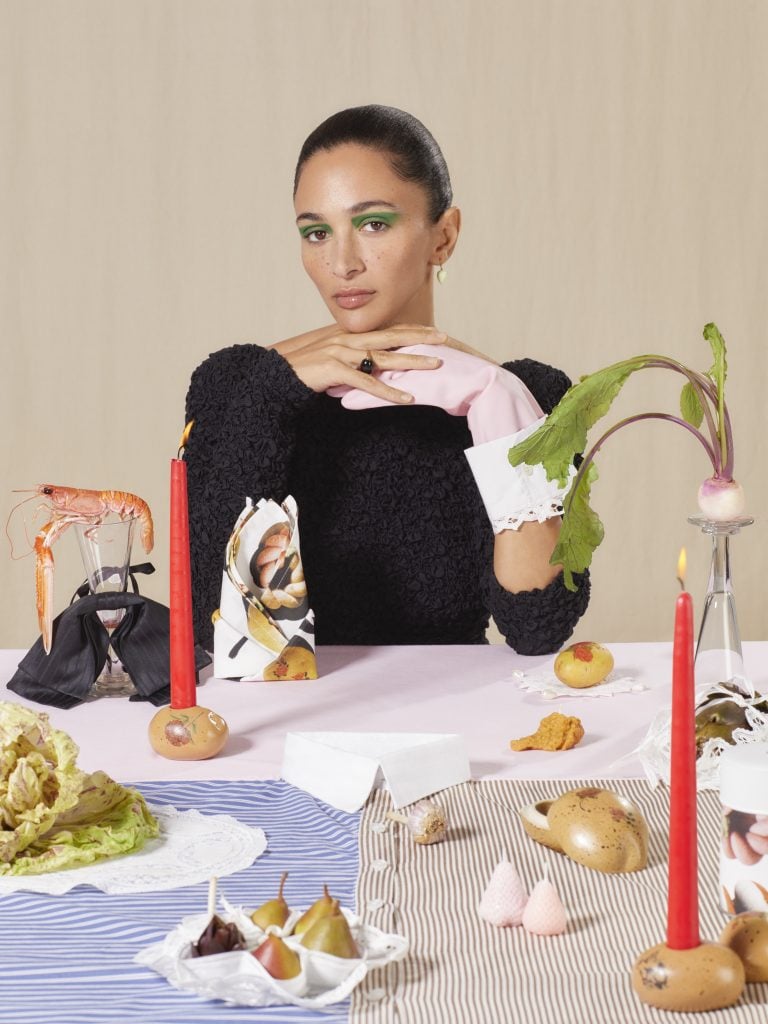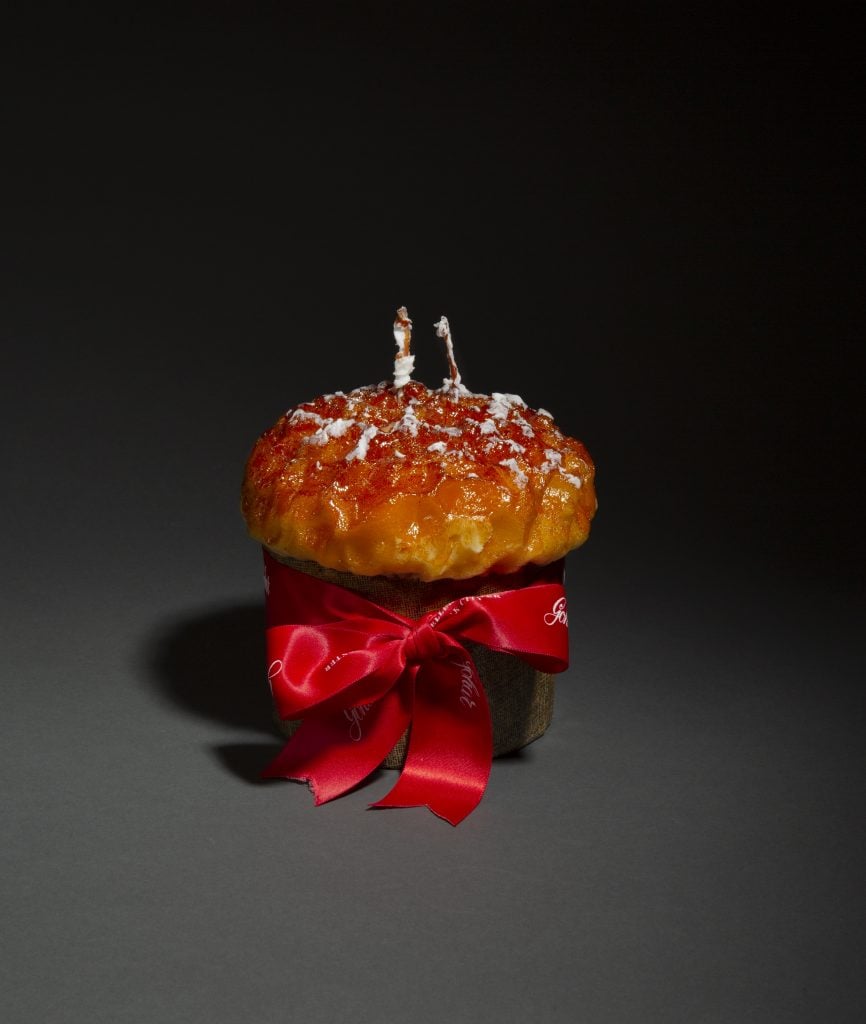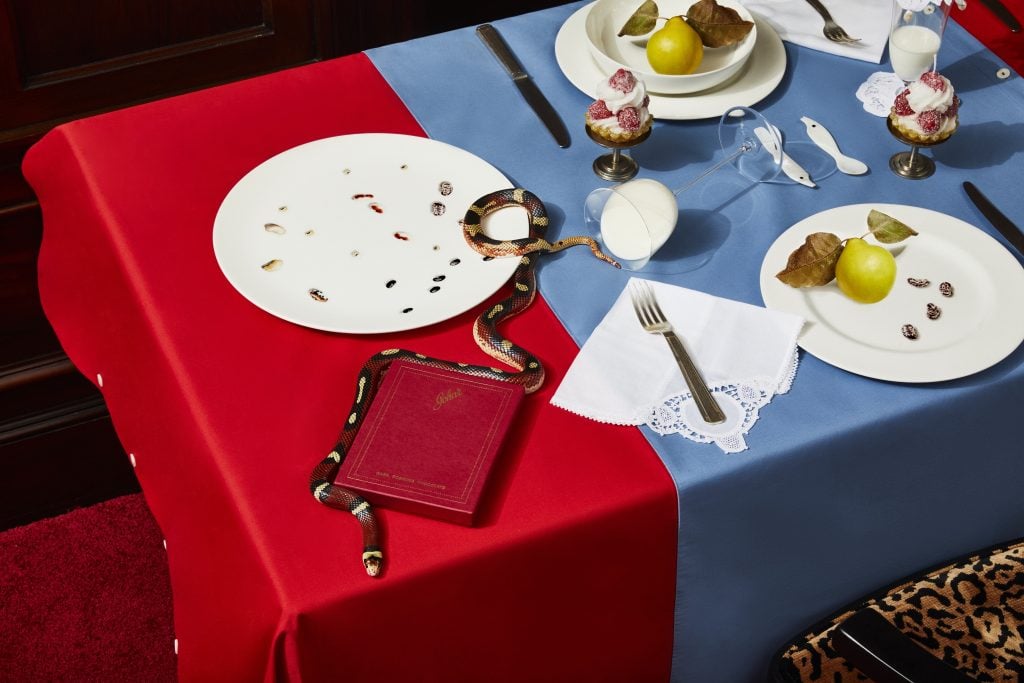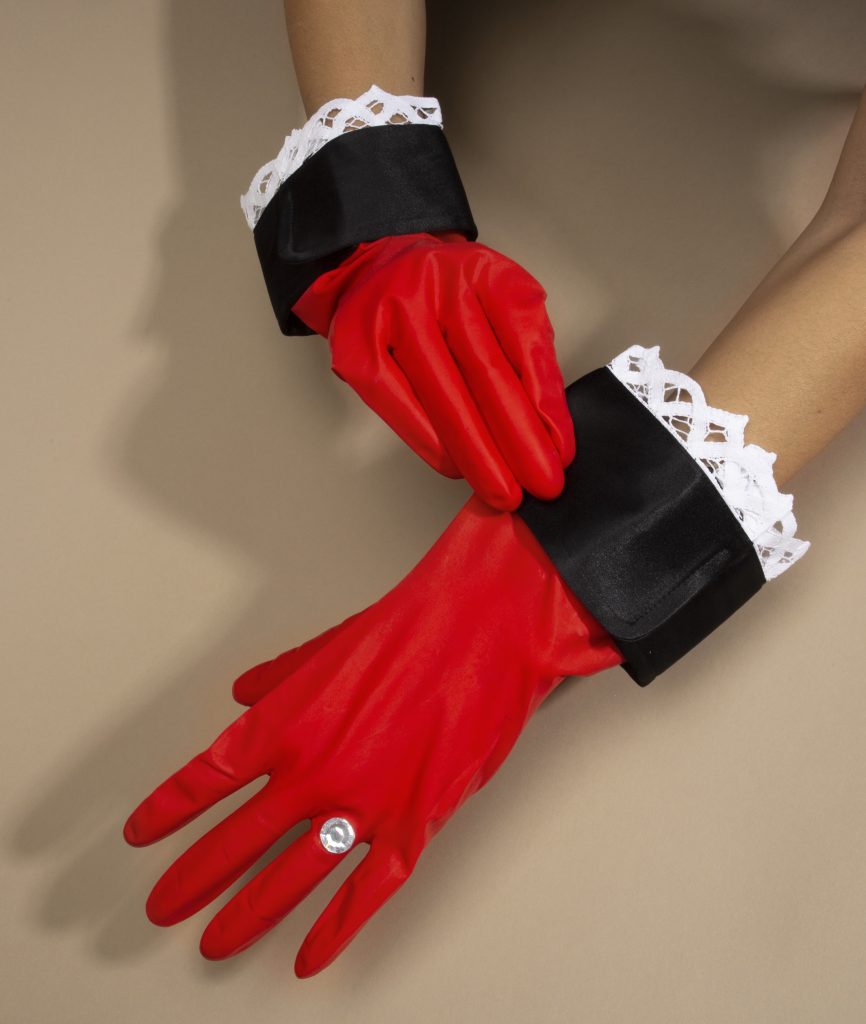People
Artist Laila Gohar Takes an Imaginative Approach to Holiday Dining, With Trompe-l’Oeil Pears and Potato Candleholders
We asked the artist, who recently launched a Surrealist-inspired tableware line, for her festive entertaining tips.

We asked the artist, who recently launched a Surrealist-inspired tableware line, for her festive entertaining tips.

Christine Ajudua

“I think about setting a table like I would about dressing myself,” said Laila Gohar. “For me, it’s another way to express style.”
While food is her medium, the Cairo-born artist has also become a fashion-world fixture, staging fantastical culinary installations for luxury brands—think Christmas trees crafted from cauliflower or roses, langoustines, and spot prawns—in art spaces and atypical settings, as well as dinner parties at her home in New York.
Now, Gohar and her painter-sculptor sister, Nadia, have launched a Surrealist-inspired tableware line called Gohar World, with helpings of humor and flair: Its new holiday collection features egg chandeliers, silk-satin bags for baguettes, pearl hats for wine glasses, panettone-shaped candles, and fancy dishwashing gloves.
Between hosting dinners for the likes of Hermès, featuring trompe-l’oeil pears sculpted from chocolate and marzipan, and unveiling a shoppable, circus-themed exhibition (through January 2, 2023) at the Little House gallery in Los Angeles, Gohar gave us her holiday hosting tips (no need for a candleholder when you have a potato handy!) and her recipe for a fragrant quince galette.

A panettone-shaped candle. Courtesy of Gohar World.
How do you typically like to spend this time of year?
I try to avoid all the craziness of holiday travel. I would much rather go away a little bit after. And that’s what we generally do.
I also really love New York during the holidays, because so many people leave and it feels like you have the city to yourself. But honestly, I just kind of lounge around my apartment [laughs].
Do you have any post-holiday travels planned?
My family and I usually go to visit my father in Guatemala. He lives in Lake Atitlán, which is remote; it takes a while to get there. We just cook and hang out and go swimming in the lake. It’s the one time in the year when we’re all together.
What sort of holiday traditions did you have growing up in Cairo?
I didn’t grow up in a very traditional household. We had a Christmas tree, but there wasn’t a big Christmas dinner or anything like that.
We celebrated a bunch of different holidays. A lot of the time it was kind of a mishmash of things that my parents did in a very non-traditional way, or even made up. It wasn’t so much about religion or whatnot; it was more about celebrations of nature and the seasons, of life and the everyday.
I now write a column for the Financial Times’s HTSI about holidays that I make up, based on things that I think are worth celebrating. That can be anything from the longest night of the year to dahlias. The next one is about celebrating cabbage.
How do you celebrate cabbage?
I love vegetables, foods in general, that are simple and humble. And I think cabbage is especially interesting because it’s really paradoxical: On one hand it’s sort of like a symbol of poverty, and then on the other hand, people really pride themselves on their usage of it—every culture has a preserved something or another with cabbage.
So I thought it was interesting to highlight cabbage in the time of the year when we’re used to things that are a lot more opulent, like caviar. Instead of doing that, go the cabbage route—which is, I think, a little out of the ordinary, but at the same time deserves the same consideration as some of these more expensive ingredients.
I think cabbage is an unsung hero. You can make things that are really beautiful out of it. For the column, I give two different recipes: One is how to make a really rich and indulgent soup that feels greater than the sum of its parts, and the other is for a stuffed cabbage that looks like a cake, almost—it’s very pretty and festive.

From the Gohar World Table II holiday collection. Photo: Jeremy Liebman.
Speaking of, do you have any tips for those hosting holiday dinner parties?
It’s good to think outside the box. People think that you need a charger and a dinner plate and the silverware on one side and the vase in the middle. I don’t think that things need to be placed so traditionally.
I personally like that my tables look unique and my own. I think about setting a table like I would about dressing myself—for me, it’s another way to express personal style.
And I like to not always use things for the purpose that they’re intended for. For example, a lot of times there are things that are already in your home that you can use to decorate the table. And the tablecloth doesn’t necessarily have to be a tablecloth—any piece of fabric that’s big enough could do. You could just repurpose things.
I don’t think it’s so necessary to spend a ton of resources on stuff all the time. It’s nice to look around and see if there’s some object in your home that could be reimagined as, say, a vase. And a vase doesn’t necessarily need to have water because it doesn’t necessarily need to have flowers—it could potentially have, like, a piece of something you foraged, or something you found, like a piece of ivy.
What do you suggest repurposing for a holiday décor?
I think the point of the repurposing is to use your imagination. For example, my boyfriend went to Martha Stewart’s store; she has these famous chickens that lay these eggs that are really oblong and beautiful. He brought me back an egg, which I thought was really romantic.
I used it—we made scrambled eggs—and then I hollowed it out, and I put a tiny little leaf in it. And now that egg has been sitting on our table since he gave it to me one week ago.
It’s just a way of thinking about things based on what draws your eye and what is available, as opposed to going and spending money on, like, another vase that you probably don’t need.
You know, I like to use candles, and not all candleholders fit the candles that I have. I just ran into this problem a few days ago: we make this really long, 24-inch candle, but we don’t make a candleholder yet, and it wasn’t fitting into mine. So one thing I do often is make a hole in a sturdy vegetable like a potato, and use that as a DIY candlestick holder. I think it looks cool.
Are there any rules of etiquette that you find particularly helpful during the holidays—or the opposite, completely worth breaking?
I think one that’s totally worth breaking is starting to do the dishes when people are still in the house. The minute people start doing dishes, the party’s over.

Gohar World’s fancy dishwashing gloves. Courtesy of Gohar World.
Is there a recipe that you like to make at this time of year, and that you’d like to share?
One of my favorite things about winter is the smell of quince. I like to buy quince whenever I see it and leave it in my home and studio for its smell. It makes the whole place smell incredible. Then I make this simple galette.
Quince Tart (serves 4–6):
3 lb quince
1 cup all-purpose flour
3/4 cup white sugar
2 tablespoons honey
6 tablespoons cold butter, plus 1 tablespoon melted for brushing
2 tablespoons turbinado sugar
3/4 cup room-temperature water
1/4 cup ice-cold water
Salt
Peel, core, and chop the quince into wedges about 1 inch wide.
Add 3/4 cup sugar, 3/4 cup water, 2 tablespoons honey, and a pinch of salt to a pot. Bring the mixture to a boil.
Add the quince to the syrup and cook over medium-low heat for about 35 minutes until the fruit is totally soft and has turned a beautiful scarlet color.
While the quince is cooking add 1 cup of flour to a bowl and a pinch of salt, and using a knife cut in 6 tablespoons of very cold butter straight from the fridge. Work quickly so the butter doesn’t get soft. Incorporate the butter and flour with your hands but leave larger pieces—this is what makes the dough flaky.
Pour in a spoonful at a time of ice-cold water and use just enough to bring the dough together. It shouldn’t be sticky—just barely enough water to bring it together into a ball.
Do not overwork the dough. Once it’s a ball, wrap in plastic wrap and chill in the fridge for an hour.
Take the dough out and roll it out til it’s about a half-inch thick. Return to the fridge for an hour.
When the quince is cooked, drain and reserve the syrup for cocktails.
Heat the oven to 375 degrees. Arrange the quince in the middle of the rolled-out dough while leaving a little space around the edge empty. Once all of the quince is in, fold the dough into the quince to make a galette shape.
Brush the exposed crust with melted butter and sprinkle with sugar. Bake the galette for 30 minutes or until brown all over. Serve with vanilla ice cream or crème fraîche.